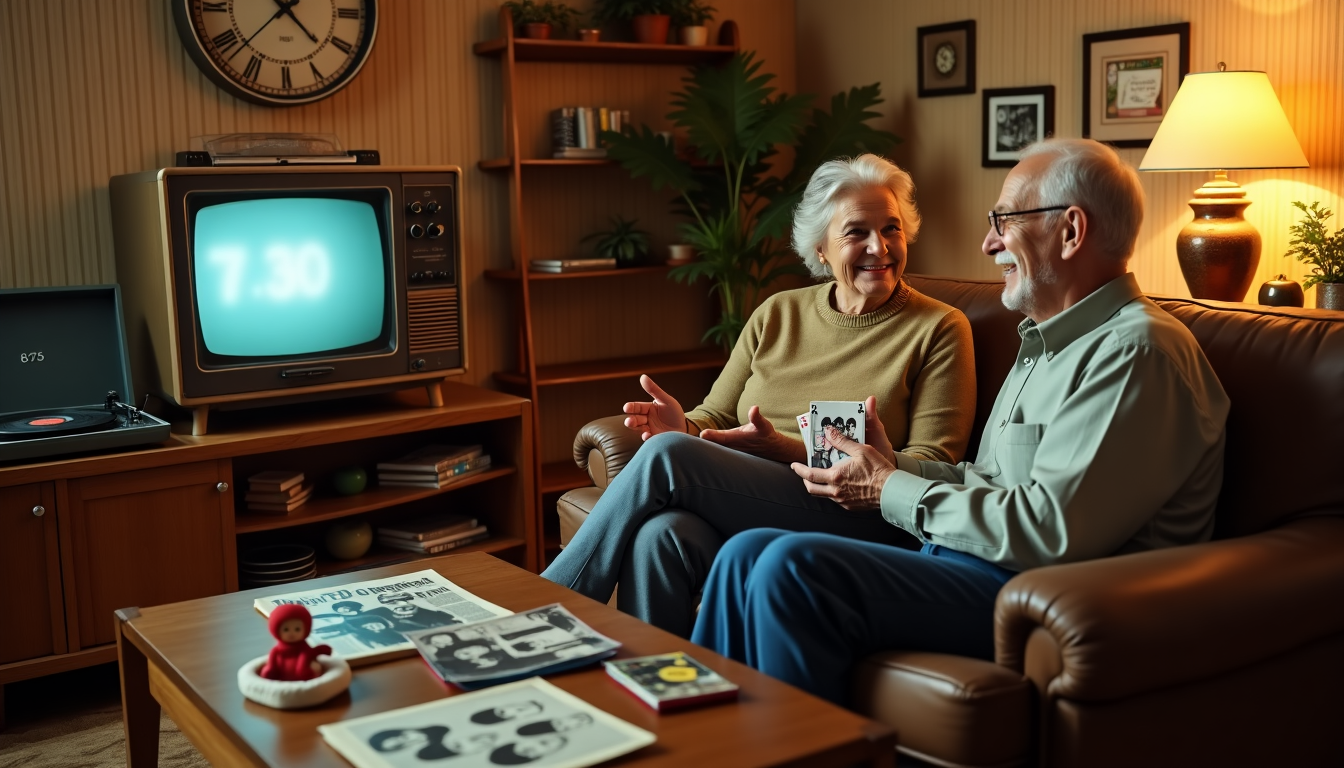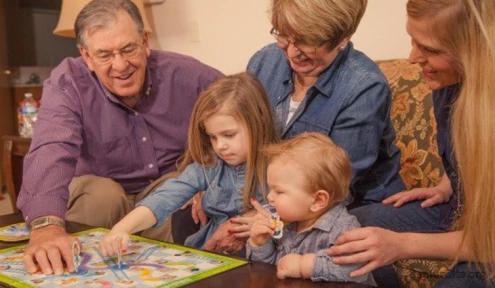Trivia games focused on the 1950s and 60s offer seniors more than just nostalgic entertainment—they provide measurable cognitive benefits. Research shows that engaging with trivia questions helps maintain mental sharpness and may slow memory decline in older adults.
Seniors who regularly participate in trivia activities experience improved mood and reduced stress levels. The social aspect of these games creates meaningful connections between participants, adding another layer of psychological benefit beyond the mental exercise.
The following trivia questions explore memorable moments spanning several decades of American culture. From iconic television programs to groundbreaking music and historical milestones, these questions cover the experiences that defined a generation. Film enthusiasts will recognize questions about Hollywood’s golden age, while those who witnessed the space race will find opportunities to recall this pivotal period in scientific advancement.
These 18 questions transport participants back to significant cultural touchpoints—covering everything from television’s talking animals to legendary musical performances that changed American entertainment forever.
What Was the First TV Show to Feature a Talking Horse?
The TV series Mister Ed made television history as the first show featuring a talking horse, running from January 1961 to February 1966. This comedy centered on Wilbur Post, a somewhat clumsy architect, and his palomino horse who mysteriously spoke only to him.
The History of Mister Ed
The show’s concept originated from Walter R. Brooks’ short stories, beginning with “The Talking Horse” published in 1937. Arthur Lubin’s secretary, Sonia Chernus, developed the television adaptation. Comedian George Burns financed the pilot at his McCadden Studio, investing approximately $70,000. When networks initially rejected the series, Lubin took an unconventional approach by selling it directly into syndication, with over 100 stations adding it to their lineups. The ratings proved so impressive that CBS purchased the show for its fall 1961 season.
Why This Show Resonated with Audiences
Mister Ed connected with viewers by offering an escape from reality through its whimsical premise. The comedic situations stemming from Ed’s selective communication created consistent humor throughout the series. The chemistry between Alan Young (Wilbur) and Bamboo Harvester (Mr. Ed) established a believable friendship that audiences found genuine. The show’s writing balanced sharp humor with a lighthearted tone, making it appropriate for family viewing. The theme song, written by Jay Livingston and Ray Evans and performed by Livingston himself, became one of television’s most recognizable opening tunes.
Fun Facts About the Talking Horse
- Bamboo Harvester, the horse portraying Mister Ed, was born in Los Angeles in 1949 and descended from a prestigious lineage of show horses.
- Despite popular myths, peanut butter wasn’t used to make Ed appear to talk. Trainer Les Hilton taught him to move his lips whenever his hoof was touched.
- Former Western film actor Allan “Rocky” Lane provided Ed’s voice but remained uncredited throughout the series’ run.
- The equine star had a notable personality off-camera, consuming 20 pounds of hay daily plus gallons of sweet tea.
- When Ed grew tired of filming, he would simply walk off set, effectively ending production for the day.
The show’s unique premise and execution make Mister Ed a rich source of trivia questions for those interested in television’s golden age.
Which Band Was Known as ‘The Fab Four’?
The nickname “The Fab Four” was given to the legendary rock group from Liverpool, England around 1963 during the height of Beatlemania. The Beatles’ publicist Tony Barrow coined this abbreviation of “Fabulous Four,” which became their permanent moniker throughout their career.
The Beatles’ Rise to Fame
John Lennon, Paul McCartney, George Harrison, and Ringo Starr formed the Beatles in 1960, evolving from Lennon’s earlier group, the Quarrymen. Their breakthrough came after manager Brian Epstein refined their image and producer George Martin developed their distinctive sound. The band conquered America in February 1964 with their appearance on The Ed Sullivan Show, attracting an estimated 73 million viewers—approximately 60 percent of the US television audience at that time. This landmark performance launched what became known as the “British Invasion” of American pop music.
Impact on 1960s Culture
The Beatles fundamentally transformed rock music by introducing innovative recording techniques and expanding the genre’s artistic boundaries. They became central figures in 1960s counterculture and youth movements across the globe. Their evolving hairstyles, fashion choices, and exploration of Eastern spirituality influenced millions worldwide. The group received MBEs (Members of the Order of the British Empire) in 1965—marking the first time such honors were given to a British pop act.
Memorable Performances and Albums
Their 1965 concert at Shea Stadium drew 55,600 fans, breaking attendance records for musical performances. The Beatles gave their final public performance at San Francisco’s Candlestick Park in 1966, after which they focused exclusively on studio work. Albums including Rubber Soul (1965), Revolver (1966), and the groundbreaking Sgt. Pepper’s Lonely Hearts Club Band (1967) revolutionized popular music and established the album format as the dominant form of music consumption.
Legacy in Modern Music
The Beatles remain the best-selling music act of all time with estimated sales exceeding 600 million units worldwide. Their influence extends beyond music into film, fashion, and broader cultural spheres. Contemporary groups from Panic! at the Disco to Foo Fighters acknowledge the Beatles’ influence on their work. Their songs continue to resonate with new generations, making them perfect subject matter for trivia questions that connect different age groups through shared cultural knowledge.
What Year Did Elvis Presley Make His First Appearance on The Ed Sullivan Show?
Elvis Presley made his first appearance on The Ed Sullivan Show on September 9, 1956, fundamentally changing American entertainment. The broadcast drew 60 million viewers, representing 82.6% of the television audience—the largest single audience in television history at that time.
The Cultural Significance of This Moment
Elvis’s debut on Sullivan’s show marked a turning point for rock and roll music’s acceptance in mainstream America. Neither Sullivan nor Elvis was actually present in the New York studio that night. Sullivan was recovering from a car accident, with British actor Charles Laughton hosting in his place, while Elvis performed remotely from CBS’s Los Angeles studio where he was filming his first movie.
This appearance helped bridge the generational gap between early rock ‘n’ roll fans and their parents. Though Elvis’s performance style had previously drawn criticism, Sullivan eventually endorsed him as a “fine young boy” after his third appearance, essentially providing the stamp of approval that made it acceptable for Americans to embrace this new musical phenomenon.
How This Changed Television Forever
Television had never united Americans in such a shared cultural experience before Elvis’s appearance. The September 9th broadcast delivered the show’s highest ratings in two years. With just three channels available at that time, family-friendly programming dominated American television.
This appearance demonstrated television’s unprecedented power to create national cultural moments. The medium itself transformed as networks recognized they could attract massive viewerships by featuring controversial yet popular artists.
Elvis’s Impact on Music
During his Sullivan debut, Elvis performed “Don’t Be Cruel,” Little Richard’s “Ready Teddy,” and “Hound Dog”. These performances helped elevate rock and roll into mainstream popular culture.
His appearances eventually opened doors for other artists, including African American musicians like Chuck Berry and Little Richard. Elvis’s influence extended beyond music into film, fashion, and broader cultural domains. By blending country, R&B, and gospel influences, he created a sound that resonated with young Americans across racial and cultural boundaries.
This landmark television moment provides perfect material for trivia questions about the pivotal cultural shifts that defined the 1950s.
Who Played the Role of Atticus Finch in ‘To Kill a Mockingbird’?
Gregory Peck’s portrayal of Atticus Finch in the 1962 film adaptation of Harper Lee’s “To Kill a Mockingbird” remains one of cinema’s most acclaimed performances. This film about racial injustice in Depression-era Alabama continues to resonate with audiences who experienced its original theatrical release.
Gregory Peck’s Iconic Performance
Peck’s portrayal of the principled lawyer earned him the 1963 Academy Award for Best Actor. His interpretation became so deeply connected with the character that Harper Lee herself observed, “When he played Atticus Finch, he had played himself, and time has told all of us something more: when he played himself, he touched the world.” At Peck’s funeral in 2003, Brock Peters (who portrayed Tom Robinson) referenced Lee’s words, noting that “Atticus Finch gave him an opportunity to play himself.”
Reflecting on the role, Peck once stated, “I put everything I had into it – all my feelings and everything I’d learned in 46 years of living, about family life and fathers and children. And my feelings about racial justice and inequality and opportunity.” Unsurprisingly, he considered Atticus his favorite role among his many performances.
The Film’s Cultural Impact
“To Kill a Mockingbird” changed how Americans discussed racial justice in public discourse. The American Film Institute named Atticus Finch the greatest movie hero of the 20th century in 2003. Martin Luther King Jr. praised the film in his 1964 book “Why We Can’t Wait,” highlighting how Atticus confronts a lynch mob “armed with nothing more lethal than a lawbook” and disperses them “with the force of his moral courage.”
Why This Character Resonated with Audiences
Atticus Finch embodied moral integrity when facing overwhelming opposition. Peck’s nuanced performance captured the character’s unwavering commitment to justice and principled stance regardless of consequences. The character continues to serve as a template for fictional lawyers and activists pursuing justice against societal pressure.
This iconic role provides excellent material for trivia questions that connect with memories of a film that helped reshape American perspectives on racial equality.
What Famous Toy Was Introduced in 1959 and Became a Cultural Icon?
Barbie debuted on the American toy market in March 1959, featuring an 11-inch plastic frame, pouty red lips, and a blonde ponytail, dressed in a black-and-white striped bathing suit. This pioneering doll became the first mass-produced toy in the United States with adult features.
The History of Barbie
Ruth Handler, co-founder of Mattel Inc., created Barbie after noticing her daughter Barbara playing with paper dolls. The doll’s design drew inspiration from a German toy called Bild Lilli, originally manufactured as an adult novelty item for tobacco shops. Handler purchased several Bild Lilli dolls during a European trip, then redesigned the concept and named it after her daughter. Barbie sold approximately 350,000 units in its first year, exceeding market projections.
How This Toy Evolved Over Decades
Mattel rapidly expanded the Barbie universe after launching the blonde original in 1959. Ken, Barbie’s boyfriend named after Handler’s son, joined the product line in 1961. Barbie’s appearance underwent softening modifications throughout the 1960s and 70s to create a more innocent look. A significant development occurred in 1980 when Mattel introduced the first Black and Hispanic Barbie dolls. The doll received its most comprehensive redesign in 2016, introducing multiple body types, skin tones, eye colors, and hair textures.
Cultural Impact and Controversies
Barbie has generated both praise and criticism throughout its history. The doll has held over 200 careers—from astronaut to presidential candidate—breaking professional barriers since the 1960s. Critics have expressed concerns about Barbie’s unrealistic body proportions (estimated at 36-18-38 if scaled to human size), suggesting potential negative influences on girls’ body image. Some observers also point to Barbie’s lifestyle as promoting materialistic values. Despite these controversies, Barbie has sold more than one billion dolls worldwide, evolving to reflect changing societal attitudes and providing rich material for trivia questions about iconic toys from past decades.
What Was the Name of the First Human to Orbit the Earth?
Soviet cosmonaut Yuri Gagarin made history on April 12, 1961, becoming the first human to journey into outer space and orbit the Earth. This achievement occurred during the height of the Cold War, creating a defining moment that remains significant in space exploration history.
Yuri Gagarin’s Historic Flight
The 27-year-old Gagarin launched aboard the Vostok 1 spacecraft at 9:07 am Moscow time, uttering the now-famous “Poyekhali!” (“Off we go!”) as his journey began. His spacecraft circled Earth at a speed of 27,400 kilometers per hour, completing the orbit in just 108 minutes. Unlike later American astronauts, Gagarin did not land inside his capsule but ejected at 7,000 meters altitude and parachuted safely to the ground—a detail Soviet officials initially concealed.
During the flight, Gagarin maintained communication with ground control, reporting that he “ate and drank” while experiencing weightlessness. He described Earth’s atmosphere as having “a very pretty and distinct blue halo” that changed “from pale blue to blue, dark blue, violet and absolutely black”.
The Space Race Context
Gagarin’s achievement represented a major victory for the Soviet Union and a setback for the United States in their ongoing space competition. This flight came just four years after the USSR launched Sputnik, the first artificial satellite, further intensifying rivalry between the superpowers. The American space program had planned its first human spaceflight for May 1961—too late to secure the historic milestone.
Soviet officials portrayed this space conquest as evidence of the “supremacy of communism over capitalism”. In response to Gagarin’s flight, President Kennedy committed the United States to reaching the moon before the decade ended.
How This Achievement Changed the World
Gagarin became an international celebrity following his successful orbit. His flight inaugurated a new era in human exploration, transforming science fiction concepts into reality. Within four months of his achievement, Gagarin toured numerous countries including Poland, Brazil, Canada, and Iceland.
The flight inspired generations of space explorers. When Neil Armstrong and Buzz Aldrin landed on the Moon in 1969, they left behind a medal honoring the Soviet pioneer. This achievement stands as one of the 20th century’s most significant moments, permanently altering humanity’s relationship with space exploration.
Which 1960s TV Show Featured the Cartwright Family?
Bonanza premiered on American television screens in September 1959, becoming one of the most enduring Western series in broadcast history. The show ran for 14 seasons until January 1973, with the Cartwright family entertaining audiences through 431 episodes.
The Legacy of Bonanza
Bonanza holds the distinction of being NBC’s longest-running Western and ranks as the second-longest Western series on American network television, behind only CBS’s Gunsmoke. The show followed the wealthy Cartwright family living on their vast thousand-square-mile ranch called the Ponderosa near Virginia City, Nevada. Unlike typical Westerns focused primarily on gunfights, Bonanza pioneered a different approach by emphasizing family relationships and moral dilemmas. The series tackled pressing social issues including racism, substance abuse, and domestic violence—subjects rarely addressed on American television during that era.
Notable Cast Members
Ben Cartwright, portrayed by Lorne Greene, headed the all-male household with his three sons from different marriages. The eldest son Adam (Pernell Roberts) brought seriousness to the family as an architectural engineer who designed the ranch house. Middle son Hoss (Dan Blocker) was characterized as a gentle giant with a kind heart. Little Joe (Michael Landon) completed the trio as the impulsive youngest brother. Roberts departed from the show in 1965 after 202 episodes due to creative differences with producers.
Why Western Shows Were Popular
By 1959, thirty Western programs dominated prime time television, with eight of the top ten shows falling into this genre during one week in March 1959. These shows helped shape American identity by promoting values of honesty, integrity, hard work, and justice. Westerns provided viewers an escape from daily life to watch heroes confront and overcome adversaries, functioning essentially as modern morality plays where good ultimately triumphed over evil.
Memorable Episodes
Fan favorites include “Hoss and the Leprechauns” (1963), considered one of the series’ most entertaining episodes, featuring Hoss convinced he had discovered leprechauns on the Ponderosa. “The Flapjack Contest” centered around a humorous eating competition with Hoss as the participant. The show maintained its freshness throughout its extended run by offering diverse storytelling ranging from action to mystery, comedy to drama.
What Dance Craze, Popularized by Chubby Checker, Swept the Nation in 1960?
The hip-swiveling phenomenon known as The Twist transformed American dance floors in 1960, creating a social revolution that freed dancers from traditional partner holds. While Hank Ballard originally wrote and recorded the song in 1958, Chubby Checker turned it into a nationwide sensation.
How to Do the Twist
The Twist gained popularity partly due to its simplicity. Dancers stood with feet shoulder-width apart, knees slightly bent, shifting their weight onto the balls of their feet. The signature movement involved swiveling the hips side to side while moving arms in opposite directions—similar to drying your back with a towel or stamping out a cigarette. Checker himself described it as simply twisting your feet back and forth on the floor while swinging your arms alternately, creating a fluid, rhythmic motion. Unlike traditional dances, performers moved independently without touching their partners, allowing for personal expression.
The Song That Started It All
Chubby Checker appeared on Dick Clark’s American Bandstand on August 6, 1960, to perform his version of “The Twist.” This television appearance launched an unprecedented dance phenomenon. The song topped Billboard charts in September 1960 and, remarkably, returned to the #1 position in January 1962—making it the first and only 45 single to reach number one in two different years. Billboard magazine later declared “The Twist” the “biggest hit” of the 1960s.
Cultural Impact of This Dance Phenomenon
The Twist fundamentally changed social dancing customs. Black Panther leader Eldridge Cleaver described it as “a guided missile, launched from the ghetto into the very heart of suburbia.” For women, the dance represented a form of liberation as they no longer needed male partners to lead them. Even First Lady Jackie Kennedy embraced the trend, occasionally hosting “Twist parties” at the White House. Many adults, however, considered the dance “too sexy” and inappropriate—some warned it could cause injuries to people over 40. The Twist’s popularity inspired numerous follow-up dances, including the Mashed Potato, the Swim, and the Funky Chicken.
What Was the First Animated Feature Film Released by Disney?
Snow White and the Seven Dwarfs made history in 1937 as Disney’s first full-length animated feature film. This groundbreaking production premiered at the Carthay Circle Theater in Los Angeles on December 21, 1937, before its general release on February 4, 1938 .
The Making of Snow White
Creating this animated landmark required extraordinary resources and commitment. The production extended over three years, cost approximately USD 1.50 million (a substantial sum during the Great Depression), and employed the talents of 32 animators, 1032 assistants, 107 inbetweeners, 10 layout artists, 25 background artists, 65 special effects animators, and 158 inkers and painters . Artists produced nearly 2 million separate paintings to complete the film . Throughout development, skeptical industry insiders referred to the project as “Disney’s Folly,” convinced it would financially ruin the young studio .
Walt Disney’s Vision
Walt Disney’s inspiration to create Snow White came from a silent film version he watched as a teenager in 1916 that deeply impressed him . In one remarkable instance, Disney gathered his core artists and personally performed the entire story, portraying all characters’ voices and movements without assistance . This passionate demonstration captivated his team and showcased Disney’s approach to animation as a serious artistic medium capable of emotional depth .
Animation Techniques Used
The film introduced pioneering animation methods, most notably the multiplane camera. This 12-foot-tall device, first tested in the 1937 short “The Old Mill,” created unprecedented visual depth by manipulating up to four layers of animation within individual frames . For human characters like Snow White, the animation team utilized rotoscoping—a technique involving filming live actors and creating animation that matched each frame .
Box Office Success
Snow White achieved remarkable commercial success upon release, generating over USD 8.00 million during its initial theatrical run . This performance made it the highest-grossing film of 1938 and temporarily the highest-grossing sound film ever produced . The Academy acknowledged this achievement with a special honorary Oscar—consisting of one standard-sized statuette accompanied by seven miniature ones—presented to Disney by child star Shirley Temple .
Who Was Known as ‘The Queen of Soul’?
Aretha Franklin earned the title “Queen of Soul” from both the music industry and fans for her unparalleled vocal talent that transformed American music. Her extraordinary range encompassed gospel, R&B, pop, and even opera, making her voice among the most versatile instruments in music history.
Aretha Franklin’s Greatest Hits
During her 60-year career, Franklin sold more than 75 million records worldwide and placed 112 singles on the Billboard charts. Her definitive recording “Respect” (1967) became an anthem for both the civil rights and women’s liberation movements. Franklin completely reimagined this Otis Redding composition by adding the iconic “R-E-S-P-E-C-T” hook and “Sock it to me” refrain. Her catalog of enduring hits included:
- “I Never Loved a Man (The Way I Love You)” (1967)
- “(You Make Me Feel Like) A Natural Woman” (1967)
- “Chain of Fools” (1967)
- “Think” (1968)
- “Rock Steady” (1971)
- “Freeway of Love” (1985)
Her Impact on Music and Culture
Franklin’s influence reached far beyond chart positions. She became the first female artist inducted into the Rock and Roll Hall of Fame in 1987. Her music provided a soundtrack for social change, with many songs serving as anthems for civil rights and women’s empowerment.
Music critic Jack Hamilton observed there was American music “before Aretha Franklin and after”. Her ability to represent the full spectrum of African-American musical traditions earned her the royal title, establishing standards that contemporary vocalists still strive to match. Throughout her career, she received numerous accolades, including 18 Grammy Awards from 44 nominations and a posthumous Pulitzer Prize special citation “for her indelible contribution to American music and culture”.
Memorable Performances
Franklin’s 1998 Grammy Awards appearance remains one of her most celebrated moments. When Luciano Pavarotti fell ill, she stepped in with just 20 minutes’ notice to perform the opera aria “Nessun Dorma”, prompting an immediate standing ovation from the astonished audience. More than one billion people worldwide witnessed this extraordinary demonstration of vocal versatility.
Her final public performance took place at the Cathedral of St. John the Divine in New York City during Elton John’s AIDS Foundation gala on November 7, 2017, where she delivered a powerful farewell, “sharing her soul with the world”.
What Iconic Hairstyle Became Popular in the 1960s, Associated with The Beatles?
The “mop top” haircut worn by The Beatles changed men’s hairstyling dramatically in the 1960s. This distinctive style—characterized by longer hair on top brushed forward and covering the ears—marked a significant departure from the slicked-back pompadours and traditional crew cuts that dominated 1950s fashion.
The Cultural Significance of the Mop Top
The mop top gained popularity among German art students before The Beatles brought it to international fame. Stuart Sutcliffe, the band’s original bassist, first adopted the style after his girlfriend Astrid Kirchherr cut his hair in 1960. Kirchherr explained the style’s origins: “All my friends in art school used to run around with this sort of Beatles haircut”. George Harrison later requested the same look, with John Lennon and Paul McCartney following suit after getting their hair cut by German photographer Jürgen Vollmer in Paris.
The androgynous hairstyle generated immediate controversy when The Beatles debuted it publicly. TIME magazine called them “mushroom haircuts” while Newsweek referred to them as “sheep-dog bangs”. The style quickly became a symbol of youth rebellion against conservative standards. As the look gained popularity, Beatles wigs appeared in stores, allowing young fans to imitate their idols without risking punishment at school.
How to Style This Classic Look
The mop top required hair grown to approximately four inches on top and across the forehead. Key characteristics included:
- Straight hair brushed downward to conceal the natural part
- A slightly longer fringe sweeping across the forehead
- Sides trimmed with sideburns at earlobe level
Each Beatle customized the basic style—McCartney’s version appeared thinner and more feathered, while Lennon’s was fuller with heavier layering.
Celebrity Influences on Fashion
The hairstyle first associated with The Beatles spread to other musicians, including the Rolling Stones and David Bowie. The look contributed to the broader counterculture movement of the late 1960s. In later decades, Liam and Noel Gallagher revived similar side-swept cuts during Oasis’s early years, followed by One Direction around 2014. K-Pop groups like BTS have continued aspects of this tradition in recent years. The mop top remains a significant cultural reference point, particularly for those who experienced this fashion revolution firsthand.
Which U.S. State Was Added as the 50th State in 1959?
Hawaii became the 50th state on August 21, 1959, when President Dwight D. Eisenhower signed the official proclamation. This historic event occurred just seven months after Alaska joined as the 49th state, completing the United States’ expansion to its current 50-state configuration.
Hawaii’s Path to Statehood
The journey to statehood for Hawaii spanned several decades, beginning well before the decisive 1959 vote. The Territory of Hawaii submitted numerous proposals to Congress throughout the early 1900s, including a joint resolution requesting statehood as early as 1903. Prince Jonah Kuhio Kalanianaole introduced the first formal statehood bill in 1919, though it failed to advance beyond committee.
A congressional committee determined in 1937 that Hawaii met all qualifications for statehood, but the Pearl Harbor attack halted progress. Territorial delegate Joe Farrington renewed efforts after World War II. During Cold War tensions, Hawaii’s multicultural population became a strategic asset in the statehood campaign, helping counter Soviet claims about American racism.
The June 1959 referendum showed overwhelming support for statehood, with 94% of Hawaiian residents voting in favor. From approximately 140,000 total votes, fewer than 8,000 opposed the Admission Act.
Cultural Celebrations
Hawaii Statehood Day, held on the third Friday of August, remains a relatively subdued holiday compared to other Hawaiian celebrations. This modest commemoration reflects the mixed feelings many native Hawaiians maintain about statehood.
The islands host numerous cultural events throughout the year that showcase Hawaii’s heritage and traditions. July’s Prince Lot Hula Festival features more than 20 premier hālau (schools) performing both ancient and contemporary hula. The King Kamehameha Celebration in June presents Hawaiian royal history through traditional song, dance, and storytelling. These events serve as essential platforms for preserving indigenous cultural practices.
Impact on American Tourism
Statehood triggered an unprecedented tourism boom that transformed Hawaii’s economy and landscape. Pan American began offering jet service to the islands just three days after admission. This improved accessibility fundamentally altered Hawaiian tourism, making it possible for middle-class travelers to afford the five-hour flight from California for approximately $100.
Construction spending increased nearly 20% by 1964 compared to the previous year, including a $27 million high-rise development on Waikiki Beach. Tourism quickly became Hawaii’s primary source of private capital. Visitors spent over $1 billion in the islands during April 2022 alone.
The economic transformation brought significant challenges alongside its benefits. Hawaii currently has the nation’s highest cost of living and one of its most expensive housing markets. Many residents must work multiple jobs to afford basic necessities, illustrating the complex consequences of Hawaii’s addition as the 50th state.
What Was the Name of the Ship That Famously Sank After Hitting an Iceberg in 1912?
The RMS Titanic earned its place in history as the “unsinkable ship” that met a tragic fate in the North Atlantic waters. This White Star Line luxury ocean liner became one of the most well-documented maritime disasters ever recorded.
The Titanic’s Final Voyage
The Titanic left Southampton, England on April 10, 1912, carrying 2,224 passengers and crew on its maiden voyage to New York City. The ship received six ice warnings on April 14, yet maintained a speed of approximately 22 knots. At 11:40 pm, lookouts spotted an iceberg directly ahead. First Officer William Murdoch ordered the ship to turn, but the response came too late—the starboard side scraped along the iceberg, damaging steel plates and breaching six of the ship’s sixteen compartments. About 13,500 tons of water flooded the vessel within 45 minutes. The ship broke apart and sank at 2:20 am on April 15, causing the deaths of more than 1,500 people.
Notable Passengers and Their Stories
The Titanic’s passenger manifest included many prominent figures from 1912 society. First-class accommodations ranged from £30 to £870 (equivalent to £3,800-£109,000 in 2023). Among the wealthy travelers were Colonel John Jacob Astor IV, the richest person aboard; Macy’s owner Isidor Straus and his wife Ida, who chose to remain together rather than separate; and Thomas Andrews, the ship’s architect. The vessel’s eight musicians played calming music as passengers boarded lifeboats during the evacuation. Below decks, the engineering team led by Joseph Bell kept the power and lights functioning until the final moments.
How This Disaster Changed Maritime Safety
The Titanic tragedy led to immediate safety reforms in maritime travel. The International Convention for Safety of Life at Sea (SOLAS) was established in 1914. Key changes included:
- Requirements that ships carry enough lifeboats for everyone aboard
- Mandatory 24-hour radio watches and lifeboat drills
- Formation of the International Ice Patrol to monitor icebergs
This disaster served as the catalyst for modern maritime safety regulations that continue to protect passengers and crew at sea today.
Who Played Mrs. Robinson in ‘The Graduate’?
Anne Bancroft portrayed the seductive Mrs. Robinson in Mike Nichols’ 1967 classic “The Graduate.” Contrary to her character’s middle-aged image, Bancroft was only 36 years old during filming—just six years older than Dustin Hoffman and merely eight years older than Katharine Ross, who played her on-screen daughter.
Anne Bancroft’s Breakthrough Role
Director Mike Nichols knew from the start that Bancroft was ideal for Mrs. Robinson. “We didn’t offer the role to anyone else except Annie,” Nichols later recalled. Bancroft took on this provocative character despite warnings that it might damage her reputation after playing the saintly Annie Sullivan in “The Miracle Worker.” Her husband, comedian Mel Brooks, encouraged her to accept the part. Costume designers enhanced Mrs. Robinson’s predatory nature by dressing Bancroft in animal prints and approximately $25,000 worth of furs. Nichols helped Bancroft discover the character’s core when he described the needed tone as “chilly, detached, almost entirely uninflected”—prompting Bancroft’s realization: “I can do that. That’s anger“.
The Film’s Impact on American Cinema
“The Graduate” became North America’s highest-grossing film of 1967 following its December release. Bancroft’s performance earned her a third Academy Award nomination. The film later gained preservation status in the U.S. National Film Registry and ranked 17th on the American Film Institute’s list of greatest American films. Despite appearing in forty additional films throughout her career, Bancroft maintained some ambivalence about Mrs. Robinson, feeling the iconic role overshadowed her other work.
Memorable Quotes and Scenes
The line “Mrs. Robinson, you’re trying to seduce me. Aren’t you?” became one of cinema’s most recognizable quotes. Many viewers don’t realize that the scene where Bancroft cups her breasts and Hoffman bangs his head against the wall was improvised rather than scripted. Film critic Roger Ebert later reassessed the film, arguing that Mrs. Robinson was actually its most complex and interesting character. Director Arthur Penn observed, “More happens in her face in 10 seconds than happens in most women’s faces in 10 years”—making Bancroft’s nuanced performance excellent material for trivia questions about classic American films.
What Famous Line is Spoken by Humphrey Bogart in ‘Casablanca’?
Humphrey Bogart’s character Rick Blaine delivers the line “Here’s looking at you, kid” four times throughout the 1942 film Casablanca. This phrase has become one of cinema’s most enduring quotes, transcending the movie to enter everyday language.
The Context Behind ‘Here’s Looking at You, Kid’
This famous line wasn’t included in the original screenplay but was improvised by Bogart during filming. The phrase first appears during the Paris flashback scenes as a toast to Ingrid Bergman’s character Ilsa, gradually evolving from a casual remark to a poignant farewell by the film’s conclusion. The line transforms from light flirtation to a bittersweet acknowledgment of their impossible relationship. Bogart reportedly created the phrase while teaching Bergman how to play poker between takes. The expression carries dual meaning—simultaneously complimenting Ilsa’s appearance while establishing emotional distance by addressing her as “kid”.
Casablanca’s Place in Film History
Casablanca has earned its reputation as “old Hollywood’s everlasting masterpiece.” Film critic Roger Ebert argued it should rank “first on the list of Movies with a capital M”. The American Film Institute has consistently recognized Casablanca among the greatest achievements in American cinema. The screenplay by Julius and Philip Epstein along with Howard Koch balances romance, suspense, and political intrigue with remarkable precision. Every line serves a specific purpose in this “trim script, which weaponises language”.
Why This Quote Remains Famous
In the decades since its release, “Here’s looking at you, kid” has appeared in contexts ranging from television commercials to recent films such as Allied (2016) and Atomic Blonde (2017). The line resonates because it captures the film’s central theme—personal sacrifice for a greater cause. As Rick states elsewhere in the film, “the problems of three little people don’t amount to a hill of beans in this crazy world”. When we reference this quote from Casablanca, we’re essentially borrowing some of its “grace under fire” ethos.
Which Motown Group Had Their First Number One Hit with ‘My Girl’?
The soulful ballad “My Girl” gave The Temptations their first #1 pop hit when it reached the top of the charts in March 1965. Released in December 1964, this signature song has remained their most recognizable recording despite numerous subsequent chart successes over their 50+ year career.
The Temptations’ Rise to Fame
The group formed in Detroit in 1961, initially calling themselves “The Elgins” before adopting their permanent name. They quickly gained attention through their polished harmonies, synchronized choreography, and stylish stage attire. The definitive “Classic Five” lineup consisted of Otis Williams, Melvin Franklin, Eddie Kendricks, Paul Williams, and David Ruffin. When original member Al Bryant departed in 1964, Ruffin joined as his replacement, bringing the distinctive vocal talent that would help define the group’s sound. Motown’s Artist Development department and choreographer Cholly Atkins contributed significantly to their performance quality, creating signature movements like the famous “Temptation Walk”.
Behind the Scenes of This Classic Song
Smokey Robinson and fellow Miracle Ronnie White wrote “My Girl” specifically for The Temptations. Robinson later explained his motivation: “I wanted to write something sweet for David Ruffin to sing”. Though Robinson initially considered having The Miracles record the song, he ultimately decided The Temptations would be more suitable. Ruffin’s unique vocal quality inspired Robinson to craft this love song as his first lead vocal with the group.
The distinctive guitar introduction that opens the track was performed by Robert White of Motown’s studio band, the Funk Brothers. The power of this musical phrase is such that Robinson noted, “I can be in a foreign country where people don’t speak English and the audience will start cheering before I even start singing ‘My Girl'”.
Motown’s Influence on American Music
Motown Records transformed America’s musical landscape by producing songs that crossed racial boundaries. The Temptations contributed significantly to this cultural shift, becoming the first Motown act to receive a Grammy Award in 1969. Their music helped unite diverse audiences during a period of social change, as they used their platform to deliver messages promoting love and unity.
What Was the Name of the First Artificial Satellite Launched into Space?
The Soviet Union launched Sputnik 1 on October 4, 1957, marking humanity’s first successful placement of an artificial satellite in Earth orbit. This beach ball-sized metallic sphere inaugurated the Space Age with a technological achievement that surprised Western nations.
Sputnik’s Historic Launch
The satellite featured a simple yet revolutionary design. Weighing 184 pounds and measuring 22 inches in diameter, Sputnik completed an orbit around Earth every 90 minutes in an elliptical path . Its polished aluminum body included four whip-like antennas extending 2.4-2.9 meters . As it traveled overhead, Sputnik transmitted distinctive “beep-beep” radio signals that amateur operators worldwide could detect . The satellite completed approximately 1400 orbits covering 70 million kilometers before its batteries failed on October 26, 1957. It eventually burned up upon atmospheric reentry on January 4, 1958 .
Cold War Implications
The launch immediately transformed global perceptions of Soviet technological capabilities. It created what many described as a “Pearl Harbor effect” on American public opinion . Sputnik demonstrated the Soviets possessed rocket technology powerful enough to potentially deliver nuclear weapons to American territory . U.S. media characterized the launch as evidence of Soviet missile superiority within 48 hours of the event . Many Americans realized their geographical isolation no longer provided security . Before reactions to the first launch fully settled, the USSR launched Sputnik 2 with the dog Laika aboard on November 3, 1957 .
How This Changed the Space Race
President Eisenhower responded to this challenge by increasing funding for America’s space program despite publicly minimizing Sputnik’s significance . After an initial setback when the Vanguard rocket exploded during launch in December 1957, the U.S. successfully placed Explorer 1 into orbit on January 31, 1958 . The Sputnik crisis directly led to NASA’s creation when Congress passed the National Aeronautics and Space Act in July 1958 . While initially shocking Americans, Sputnik ultimately accelerated both the space race and arms race, intensifying Cold War rivalries while simultaneously catalyzing unprecedented scientific advancement .
Who Was the Host of the 1950s Variety Show ‘The Ed Sullivan Show’?
Edward Vincent Sullivan began his career as a newspaper columnist with minimal television experience before becoming one of America’s most influential cultural gatekeepers. His program holds the record as the longest-running variety show in U.S. broadcast history. The show aired from 1948 to 1971, initially titled “Toast of the Town” before being renamed “The Ed Sullivan Show” in 1955.
Ed Sullivan’s Influence on Television
Sullivan maintained a notoriously stiff, awkward on-camera persona, yet possessed remarkable talent for identifying entertainers with star potential. Television critic David Hinckley described it as “the last great American TV show”. Sullivan consistently broke racial barriers by featuring African American performers when other shows refused to do so. He defied sponsor pressure by holding hands with Pearl Bailey on air and personally paid for Bill “Bojangles” Robinson’s funeral when the dancing legend died without funds. Sullivan’s stance against discrimination stemmed from his Catholic upbringing, as he explained: “As I grew up, the causes of minorities were part and parcel of me”.
Famous Guests and Performances
Sullivan’s stage launched countless defining moments in American popular culture. His program featured 73 performers who later entered the Rock and Roll Hall of Fame, beyond just Elvis and The Beatles. The Dave Clark Five appeared on the show 13 times—more than any other British group. Unlike many television programs of the era, Sullivan required most musical acts to perform live rather than lip-sync. His show embraced entertainment diversity, showcasing everything from opera singers to puppet characters like Topo Gigio.
Why This Show Was a Cultural Phenomenon
Sullivan’s Sunday night broadcasts at 8 PM evolved into a national ritual, with families gathering around television sets across America. John Leonard observed that “There wasn’t an important Black artist who didn’t appear on Ed’s show”. The program presented an extraordinary range of entertainment, from Broadway performers to plate spinners, creating what many considered a truly democratic variety experience. This groundbreaking show continues to provide rich material for trivia questions about television’s formative period in American cultural history.
Comparison Table
| Question/Topic | Answer/Detail | Year/Time Period | Notable Facts | Cultural Impact |
|---|---|---|---|---|
| First TV Show with Talking Horse | Mister Ed | 1961-1966 | Cost $70,000 to produce pilot; Horse was played by Bamboo Harvester | First show to feature a talking horse; Became an instant classic |
| Band Known as ‘The Fab Four’ | The Beatles | 1960s | Nickname coined by publicist Tony Barrow | Best-selling music act of all time (600+ million units) |
| Elvis’s First Ed Sullivan Show | Elvis Presley | September 9, 1956 | Attracted 60 million viewers (82.6% of TV audience) | Largest single TV audience in history at that time |
| Atticus Finch Actor | Gregory Peck | 1962 | Won 1963 Academy Award for Best Actor | Named greatest movie hero of 20th century by AFI |
| Famous Toy from 1959 | Barbie | 1959 | Sold 350,000 units in first year | First mass-produced doll with adult features in US |
| First Human to Orbit Earth | Yuri Gagarin | April 12, 1961 | Flight lasted 108 minutes; Spacecraft: Vostok 1 | First human in space; launched Space Age |
| TV Show with Cartwright Family | Bonanza | 1959-1973 | Ran for 431 episodes | NBC’s longest-running Western |
| 1960 Dance Craze | The Twist | 1960 | Popularized by Chubby Checker | First song to reach #1 twice on Billboard charts |
| First Disney Animated Feature | Snow White | 1937 | Cost $1.50 million to produce; Used 2 million paintings | Highest-grossing film of 1938 |
| Queen of Soul | Aretha Franklin | Career span: 60 years | 18 Grammy Awards; 112 Billboard singles | First female inducted into Rock & Roll Hall of Fame (1987) |
| Beatles’ Iconic Hairstyle | The Mop Top | Early 1960s | Originally popular among German art students | Sparked controversy and cultural revolution |
| 50th US State | Hawaii | August 21, 1959 | 94% of residents voted for statehood | Led to major tourism boom |
| Famous Sinking Ship | Titanic | April 15, 1912 | 2,224 passengers; 1,500+ deaths | Led to major maritime safety reforms |
| Mrs. Robinson Actor | Anne Bancroft | 1967 | Was only 36 during filming | Earned third Academy Award nomination |
| Bogart’s Famous Line | “Here’s looking at you, kid” | 1942 | Said 4 times in the film | Became part of cultural lexicon |
| Motown Group’s First #1 | The Temptations | March 1965 | Song: “My Girl” | First Motown act to win Grammy (1969) |
| First Artificial Satellite | Sputnik 1 | October 4, 1957 | Weighed 184 pounds; Orbited every 90 minutes | Launched Space Age; Led to creation of NASA |
| Ed Sullivan Show Host | Ed Sullivan | 1948-1971 | Longest-running variety show in US TV history | Launched careers of many famous performers |
Conclusion
These classic trivia questions document a remarkable period of cultural and technological innovation. From Sputnik’s radio signals orbiting Earth to Elvis Presley’s groundbreaking television appearances, each question highlights pivotal moments that defined mid-20th century America.
The cultural artifacts referenced in these questions represent more than historical curiosities. Sputnik’s launch fundamentally altered international relations and scientific priorities, while Barbie’s introduction changed children’s play patterns for generations. The Beatles challenged conventional masculinity through their distinctive mop top hairstyles, as Aretha Franklin’s powerful vocals provided an emotional soundtrack for social movements. Television programs like Mister Ed and Bonanza established shared national viewing experiences that united diverse American households.
The impact of these cultural milestones has intensified rather than diminished with passing decades. Maritime regulations implemented after the Titanic disaster continue saving lives at sea. Hawaii’s admission as the 50th state completed the modern United States configuration. Gregory Peck’s portrayal of Atticus Finch remains a reference point for principled moral courage in American storytelling. These historical touchpoints connect different generations through common cultural knowledge.
Trivia questions based on these topics serve multiple purposes for senior participants. Beyond providing cognitive exercise, they activate personal memories and prompt meaningful conversations about lived experiences. Each question potentially unlocks firsthand accounts and perspectives, preserving valuable historical context through shared recollections.












